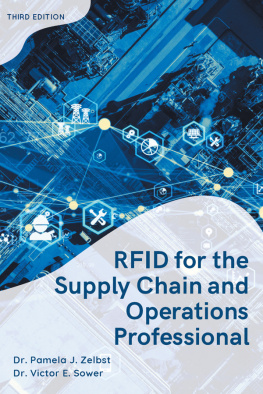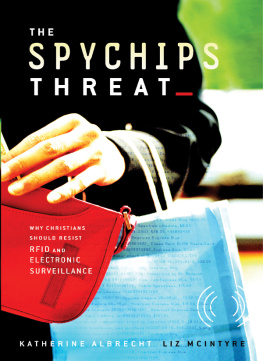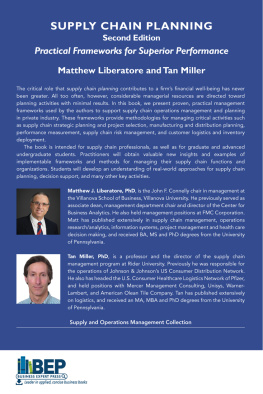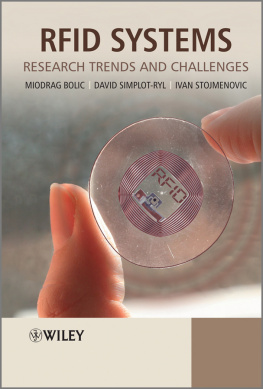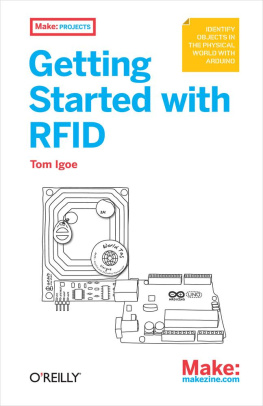RFID for the Supply Chain and Operations Professional
RFID for the Supply Chain and Operations Professional
Third Edition
Pamela J. Zelbst and Victor E. Sower

RFID for the Supply Chain and Operations Professional, Third Edition
Copyright Business Expert Press, LLC, 2022.
Cover design by Charlene Kronstedt
Interior design by Exeter Premedia Services Private Ltd., Chennai, India
All rights reserved. No part of this publication may be reproduced, stored in a retrieval system, or transmitted in any form or by any meanselectronic, mechanical, photocopy, recording, or any other except for brief quotations, not to exceed 400 words, without the prior permission of the publisher.
First published in 2012 by
Business Expert Press, LLC
222 East 46th Street, New York, NY 10017
www.businessexpertpress.com
ISBN-13: 978-1-63742-143-7 (paperback)
ISBN-13: 978-1-63742-144-4 (e-book)
Business Expert Press Supply and Operations Management Collection
Collection ISSN: 2156-8189 (print)
Collection ISSN: 2156-8200 (electronic)
Third edition: 2021
10 9 8 7 6 5 4 3 2 1
Description
The quality and effectiveness of decisions made within an organization and its supply chain depend on the accuracy and timeliness of the information on which they are based. Radio-frequency identification (RFID) is a technology that can provide more accurate information in near real time and thus increase the quality and timeliness of decisions based on that information. RFID systems are currently in use in areas such as inventory management, process control, asset tracking and monitoring, and retail point of sale. Organizations that appropriately incorporate RFID into their operations and information management systems have increased their agility, effectiveness, and efficiency, resulting in organizational growth and increased profitability.
The appropriate utilization of RFID allows organizations to become more agile, resulting in their ability to respond to customers more efficiently and effectively. Technology by itself does not result in improvements, and RFID is no exception. RFID is not a solution for every problem. However, when coupled with other appropriate technologies to address an appropriate objective, RFID can offer a variety of benefits to businesses. The proper integration of RFID into the firms competitive plans and processes provides the ability to leverage the technology for competitive advantage and results in increased performance for organizations.
The intent of this book is to provide a sufficient discussion of RFID to enable readers with no prior knowledge to develop a basic understanding of the technology. The book discusses current applications and specific examples of RFID usage taken from a variety of industries. The appropriate coupling of RFID with other technologies such as global positioning systems (GPS), enterprise resource planning (ERP), and robotics is discussed, as well as an overview of the RFID implementation process. This book helps readers develop an understanding of the capability of the technology to increase an organizations customer responsiveness.
In the third edition, the discussion and examples have been updated to reflect the rapid advancement in RFID technology. A new case study and new examples have been added along with updated discussions and projections about RFID technology.
Keywords
RFID timeliness; RFID implementation; RFID integration; Industrial Internet of Things; real-time information systems; effectiveness; efficiency; agility; asset tracking; customer responsiveness; inventory management
Contents
This book is the perfect primer for the uninitiated manager struggling to understand RFID technology and how the technology can be used to solve problems related to existing operations and supply chain management. The book is clear and concise and easily understood due to the nontechnical approach adopted by the authors. The reader is introduced to RFID technology and instructed in the essentials and uses of the technology. As the reader begins to appreciate the technology, the authors provide the reader examples of solutions from all sectors. The book is full of excellent examples of how the technology has been used to solve existing problems. The reader will take away an understanding of the capabilities of the technology to improve efficiency, effectiveness, and responsiveness throughout product and service delivery processes. In addition to the plethora of examples, the authors offer several in-depth cases that illustrate successful applications of RFID technology in multiple settings. Once you understand the technology and its potential value, the authors provide a step-by-step approach to successfully implementing RFID systems. Finally, they discuss the future of RFID technology utilization. Essentially, the authors describe how RFID technology can be used to strategic advantage. Dr. Kenneth Green, Jr., LeMay Professor of Technology, Southern Arkansas University
This book does a great job of introducing and explaining RFID technology, what makes it work, and the various settings and applications where it can improve process flows. I am now more aware of where I might encounter RFID technology, where and when it could be used to improve processes, and how to add value to an organization.Mr. Ken Holland, Continuous Improvement Program Manager, Supply Chain Operations, Freescale, Inc.
If you are looking for an overview of radio-frequency identification (RFID) technology, examples of how RFID is being used effectively everywhere from hospitals to warehouses, and guidelines for implementing an RFID system, this is the book for you. The authors discuss the benefits of RFID compared to similar technologies, and new applications for its use in the future.Inbound Logistics, January 2013, p. 274. Review of First Edition
ADC | automatic data capture |
AFSP | average factory selling price |
AIDC | automatic identification and data capture |
AII | auto ID infrastructure |
AIM | Association for Automatic Identification and Mobility |
AIT | automatic information technology |
ANSI | American National Standards Institute |
aRFID | active radio-frequency identification |
CNC | computer numerical control |
DARPA | Defense Advanced Research Projects Agency |
DLA | Defense Logistics Agency |
DOD | Department of Defense |
EAS | electronic article surveillance |
EM | event management |
EMEA | Europe, the Middle East, and Africa |
EMV | Europay MasterCard Visa |
EPC | Electronic Product Code |
ERP | enterprise resource planning |
ETSI | European Telecommunications Standards Institute |
FCC | Federal Communications Commission |
|

